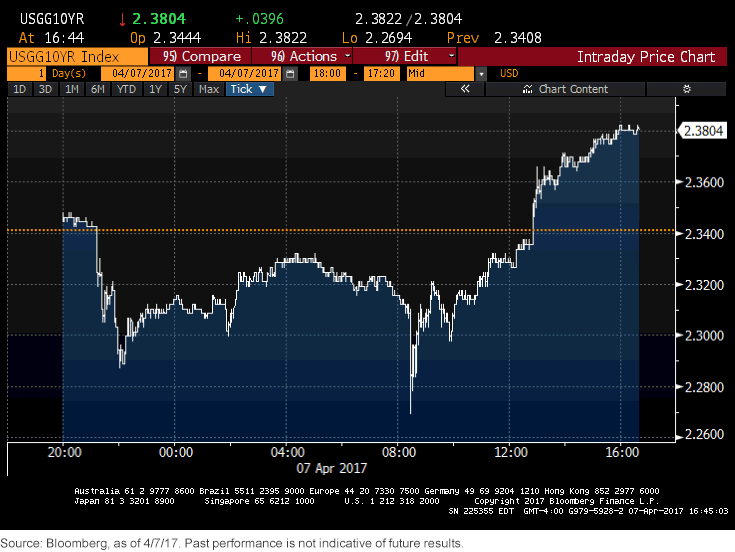Fixed Income: Have You Heard the News?


Last week, specifically the latter half, offered the bond market a lot of news to digest. It certainly came in different forms as well, whether it was geopolitical, Federal Reserve (Fed)-related or economic. As a result, we thought it would be useful to offer some brief insights regarding these developments’ current or in some cases potential impact on the fixed income arena.
Geopolitical
The launching of Tomahawk missiles into Syria on Thursday night takes top billing. Geopolitical developments are always a wild card when it comes to market valuations, but the knee-jerk response in the fixed income arena went according to script. In other words, Treasuries rallied. Whether this factor remains a market influence will depend on whether developments escalate. In my opinion, a U.S. missile attack that is only followed with tough rhetoric, and no counter actionable response from Russia, Syria and/or Iran, does not rise to that threshold.
The enclosed graph provides a glimpse into trading activity for the 10-Year U.S. Treasury (UST) yield the night of the missile attack and for the subsequent “jobs Friday.” As you can clearly see, as the attack was hitting the wires, the 10-Year yield dropped 6 basis points (bps) to roughly 2.29%. This was the first move below the 2.30% threshold since November. As recently as March 13, the 10-Year yield was 2.63%.

The Fed
Next up, the Fed. In this case, we’re referring to the release of the March FOMC minutes where the policy makers provided more “color” surrounding their balance sheet plans. The surprise here was that the Fed included not just agency mortgage-backed securities, but also their Treasury holdings in the discussion of either outright ending or phasing out their current reinvestment policy. Fed UST holdings are rolled over at auction; thus, if the Fed ceases to reinvest the proceeds at maturity, the Treasury needs to make up for this shortfall by issuing more debt to the public. The key here is where on the yield curve this shortfall would be made up. There’s a big difference between issuing more t-bills versus more 5-, 10- or 30-year paper, as the latter carries more potential interest rate risk.
Also, recent comments from New York Fed president William C. Dudley addressed the combination of rate hikes and the balance sheet. In particular, Dudley mentioned that when the Fed decides to reduce or end reinvestments, perhaps the policy makers should also consider a “little pause” in their rate hike cycle to observe how the markets respond to the balance sheet part of the process. The UST market appeared to interpret his first comments on this subject as the Fed using its altered reinvestment policy in lieu of future rate hikes. If economic and financial conditions don’t change from the Fed’s outlook, the policy makers could start the balance sheet process late in 2017 or early 2018.
Jobs
Finally, the jobs report. It was a strange report, to say the least, with the headline nonfarm payroll figure coming in far less than expected at +98,000. However, it looks like this could have been weather-related due to the East Coast snowstorm in mid-March. On the other side of the ledger, the unemployment rate dropped 0.2 percentage points to 4.5%, a nearly 10-year low. The alternate measure, civilian employment, surged by 472,000. Typically, these two measures come into better alignment over time. Although average hourly earnings fell a modest 0.1 percentage points to +2.7% on a year-over-year basis, the recent upward range for wages was maintained.
Conclusion
With all this news taken together, the Fed still appears to be on track for another rate hike in June. For the record, there is an FOMC meeting prior to June, slated for May 2–3. One last point: The 10-Year UST yield did drop to a low of 2.27% on Friday, but it could not hold there, maintaining the 2.25% to 2.65% trading range for now.
Unless otherwise noted, source is Bloomberg, as of April 7, 2017.


